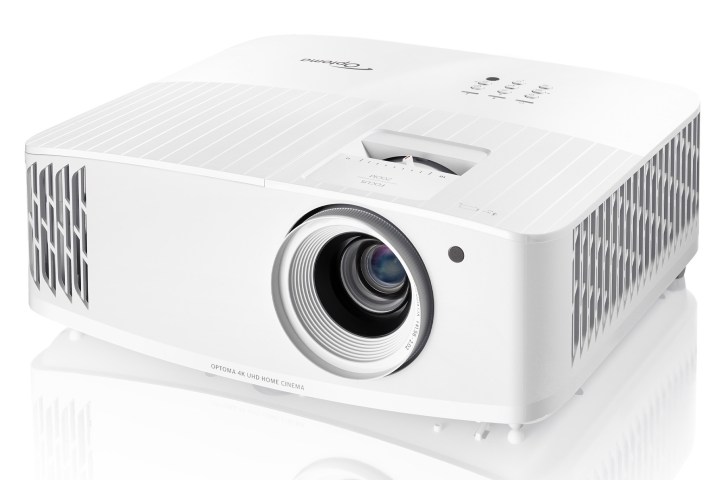
Optoma has unveiled two new 4K HDR home theater projectors, the $1,300 UHD35 and its slightly more powerful sibling, the $1,400 UHD38. They look like just about every other bulb-based projector on the market, but inside their plain white shells, Optoma has included some technology that will make these models a lot more appealing to gamers.
Home theater projectors do one thing really well: They provide the largest image size for the lowest price. A nice, big 150-inch image or larger is a real tempting way to play console or PC games, but the downside of these projectors is that their input lag and response times are usually too slow for serious gamers, who need things to be as fast as possible. That’s where the UHD35 and UHD38 come in.

Equipped with an Enhanced Gaming Mode, the two projectors boast an input lag as low as 4.2 milliseconds. That might not seem like a big deal when compared to dedicated gaming monitors, which can get as low as 0.7ms, but in the world of projectors, the UHD35 and UHD38 are speed demons — almost twice as quick as the previous fastest model, Optoma’s own HD39HDR .
Response times are equally impressive. If you set your game’s resolution and refresh rate at 1080p at 240Hz, the UHD3X models can turn in a blistering performance of 4.2ms. Even their slowest response rate of 16.7ms when using 4K at 60Hz is not too shabby as far as projectors go.

Those specs are going to please gamers for sure, but these projectors look to be every bit as capable for standard viewing. too. The difference between the two models as you’re no doubt wondering is brightness. The UHD35 kicks out 3,600 lumens, while the UHD38 can output 4,000 lumens. Their bulbs are rated for up to 15,000 hours of life before needing to be changed. They support both HLG and HDR10 formats of high dynamic range (HDR) material. There is also support for Rec.709 and DCI-P3 color spaces, though Optoma hasn’t said what percentage of each the projectors can display.
Optoma claims that, unlike other projectors that are labeled 4K UHD but actually have a lower native resolution, the UHD35 and 38 have a real native resolution of 3840 x 2160 — which has earned these two models a True
Image sizes can get as large as 300 inches depending on the distance from the screen. The back panel sports two HDMI 2.0 with HDCP 2.2 inputs in addition to a VGA port, a powered USB port, an optical output, an analog input and output for audio, and a 12-volt trigger port for use with motorized screens.
Though we can’t imagine anyone will want to use it, there’s also a built-in 10-watt speaker, just in case your need to game on a huge screen takes you away from your home theater setup.
Editors' Recommendations
- What we want to see from the next Apple TV 4K
- Samsung’s new 98-inch DU9000 4K TV is just $4,000. Can it beat TCL and Hisense?
- Vizio’s first 86-inch 4K TV is coming soon, for $999
- Hands-on with the Belkin iPhone Mount with MagSafe for Apple TV 4K
- Belkin drops a $50 mount for iPhone video calls on Apple TV 4K




